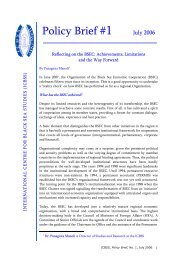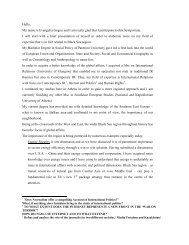Xenophon Paper 2 pdf - ICBSS
Xenophon Paper 2 pdf - ICBSS
Xenophon Paper 2 pdf - ICBSS
You also want an ePaper? Increase the reach of your titles
YUMPU automatically turns print PDFs into web optimized ePapers that Google loves.
The very concept of various paces of EU integration in a region imposes two possible<br />
perspectives on the member states’ cooperation. The first is one of positive competition,<br />
where those states that lag behind in the integration activities are motivated to catch up<br />
with those that are ahead and thus the entire process gains speed. This is a perspective<br />
articulated in relation to the Partnership for Peace and NATO accession by Radovan<br />
Vukadinoviç. Alternatively, the author has argued that a multiple pace of integration can<br />
also inflict damage on the region by fostering negative feelings and resentment among<br />
the member states. The latter should be taken into account as a counter-factor when<br />
designing any multi-faceted and ‘multi-gear’ integration where similar countries are<br />
treated differently. 3<br />
The states in the Black Sea region vary greatly in the degree of internal stability that<br />
they can maintain. For many, the major security challenge is to gain control of their own<br />
borders. 4 Additionally, minority issues and the disintegration of institutions born in former<br />
regimes represent a cause in the rise of organised crime that includes everything from<br />
arms trafficking to human smuggling. The question mark over the EU’s final borders<br />
certainly becomes an aggravating factor. Indeed, “wherever (these borders) are finalised,<br />
immediate neighbours to the East and South will comprise the ‘frontier zone”. 5<br />
One way of addressing the internal instability is to say that “(s)haring the same problems<br />
with the neighbouring regions, the Black Sea states are to collaborate with neighbours<br />
in achieving more secure environment, with the assistance of the USA, NATO, and the<br />
EU”. 6 This suggests again that the best ‘multilateral’ way to deal with internal security<br />
in the Black Sea area is to share issues with the neighbouring states and to follow the<br />
path to the EU. In short, the suggested approach includes a bandwagoning behind the<br />
most advanced aspirants to EU membership or, in the case of the BSEC, behind an EU<br />
member, Greece. In this light, Greece emerges as the leader of the Black Sea Group.<br />
If EU membership is to be the beacon light for the Black Sea region, what guiding<br />
principle will apply for its larger members whose membership prospects in the EU are<br />
either non-existent, or dim, such as the Russian Federation and Turkey? In addition, is<br />
the road to the EU really such an unequivocally efficient solution to the region’s diverse<br />
3 See Vukadinovic, Radovan (1997), ‘The Enlargement of NATO and the Countries of the Former Yugoslavia’,<br />
Peace and Security, vol. 29, September, pp. 13–23; Fatic, Aleksandar (1998) ‘Expansion in a Ghastly light’,<br />
Peace and Security, vol. 30, March, pp. 36–40. See as a summary of the discussion Fatic, Aleksandar and Milan<br />
Popovic (1999), ‘NATO expansion and Balkan testing grounds’, Peace and Security, vol. 30, December, pp.<br />
36–42.<br />
4 Petersen, Philip. A. (2006), ‘The Black Sea: Frontier Zone or ‘European Sea’’, Review of International Affairs,<br />
vol. LVII, no. 1122, April–June, p. 23.<br />
5 Ibid.<br />
6 Ibid.<br />
X E N O P H O N P A P E R no 2 123









